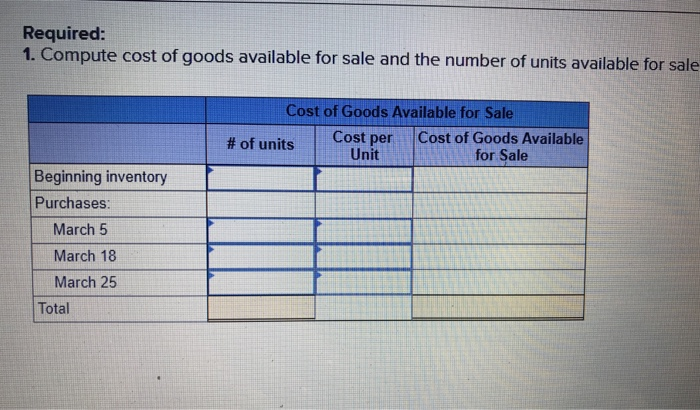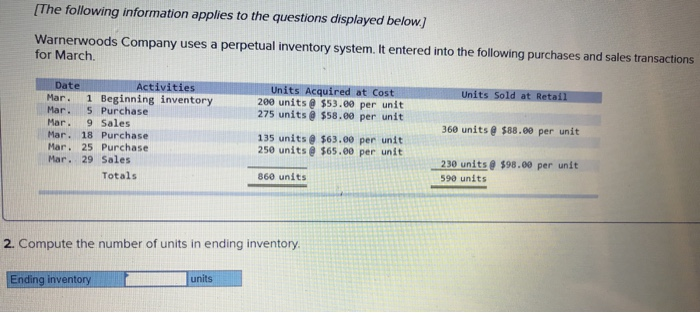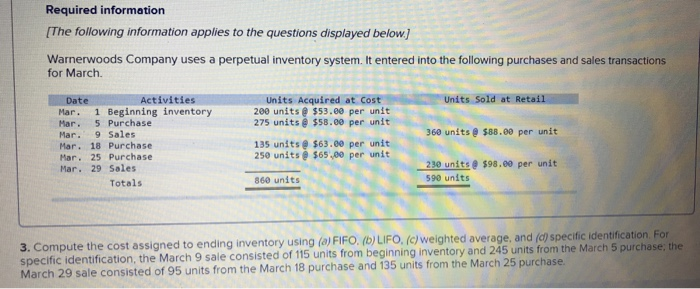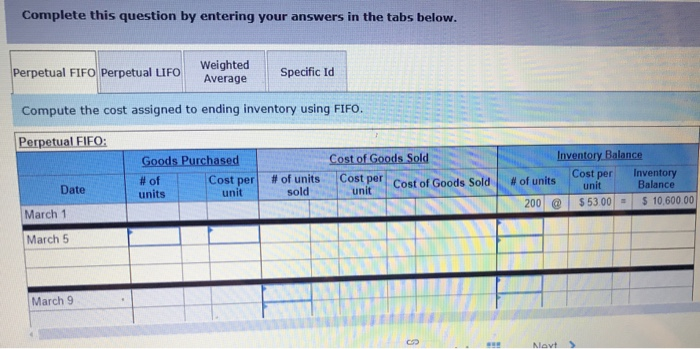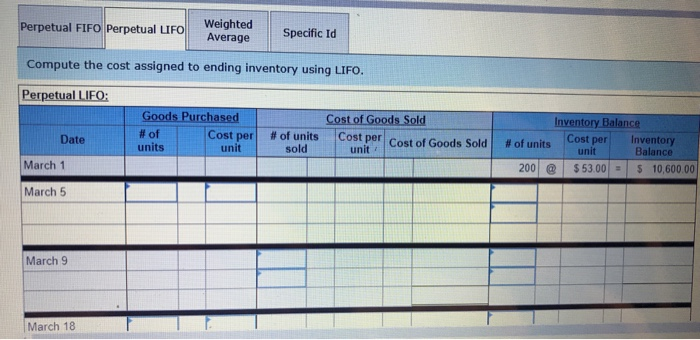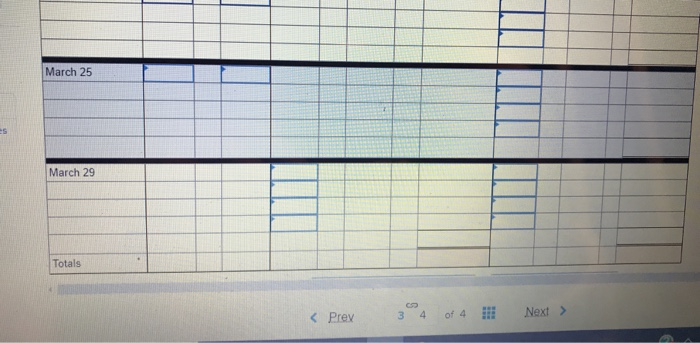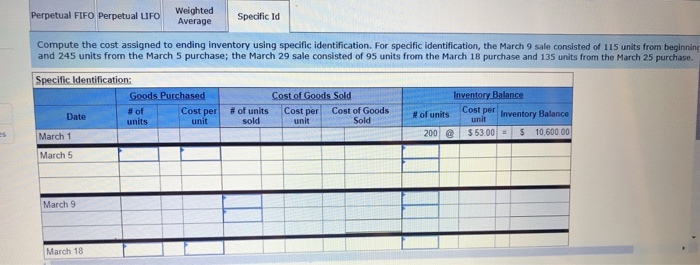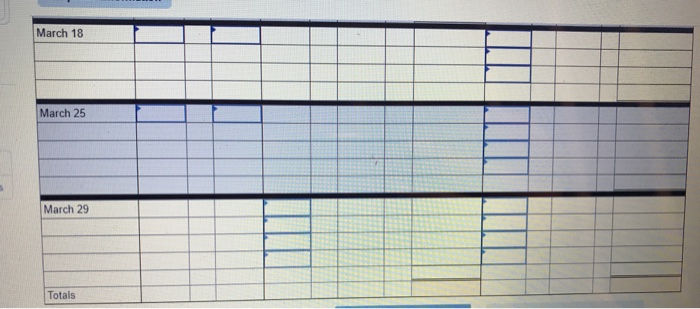! Required information [The following information applies to the questions displayed below) Warnerwoods Company uses a perpetual inventory system. It entered into the following purchases and sales transactions for March Units Sold at Retail Units Acquired at Cost 200 units @ $53.00 per unit 275 units @ $58.00 per unit 360 units@ $88.00 per unit Date Activities Mar. 1 Beginning inventory Mar. 5 Purchase Mar. 9 Sales Mar. 18 Purchase Mar. 25 Purchase Mar. 29 Sales Totals 135 units@ $63.00 per unit 250 units @ $65.00 per unit 230 units@ $98.00 per unit 590 units 860 units Required: 1. Compute cost of goods available for sale and the number of units available for sale. Required: 1. Compute cost of goods available for sale and the number of units available for sale Cost of Goods Available for Sale Cost of Goods Available # of units Unit for Sale Cost per Beginning inventory Purchases: March 5 March 18 March 25 Total [The following information applies to the questions displayed below.) Warnerwoods Company uses a perpetual inventory system. It entered into the following purchases and sales transactions for March Units Sold at Retail Date Activities Mar. 1 Beginning inventory Mar. 5 Purchase Mar. 9 Sales Mar. 18 Purchase Mar. 25 Purchase Mar. 29 Sales Totals Units Acquired at Cost 200 units @ $53.00 per unit 275 units @ $58.00 per unit 135 units@ $63.00 per unit 250 units @ $65.00 per unit 360 units@ $88.00 per unit 860 units 230 units@ $98.00 per unit 590 units 2. Compute the number of units in ending inventory Ending inventory units Required information [The following information applies to the questions displayed below.) Warnerwoods Company uses a perpetual inventory system. It entered into the following purchases and sales transactions for March Units Sold at Retail Date Activities Mar. 1 Beginning inventory Mar 5 Purchase Mar. 9 Sales Mar. 18 Purchase Mar. 25 Purchase Mar. 29 Sales Totals Units Acquired at Cost 200 units @ $53.60 per unit 275 units @ $58.00 per unit 135 units@ $63.00 per unit 250 units @ $65.00 per unit 368 units $88.00 per unit 230 units @ $98.00 per unit 590 units 860 units 3. Compute the cost assigned to ending inventory using (a) FIFO. (b) LIFO. (c) weighted average, and (d) specific identification. For specific identification, the March 9 sale consisted of 115 units from beginning inventory and 245 units from the March 5 purchase the March 29 sale consisted of 95 units from the March 18 purchase and 135 units from the March 25 purchase. Complete this question by entering your answers in the tabs below. Perpetual FIFO Perpetual LIFO Weighted Average Specific Id Compute the cost assigned to ending inventory using FIFO. Perpetual FIFO: Goods Purchased Cost of Goods Sold Inventory Balance # of Cost per Inventory Cost per Cost per # of units sold Date Cost of Goods Sold # of units units unit unit unit $53.00 = Balance $ 10,600.00 200 @ March 1 March 5 March 9 Mayt Perpetual FIFO: Cost of Goods Sold Goods Purchased # of units unit Cost per Cost per # of units sold Date Cost per Inventory Balance # of units Inventory unit Balance 200 @ $ 53.00 = $ 10,600.00 Cost of Goods Sold unit March 1 March 5 March 9 March 18 March 25 NAVE March 25 March 29 Totals Perpetual FIFO Perpetual LIFO Weighted Average Specific Id Compute the cost assigned to ending inventory using LIFO. Perpetual LIFO: Cost of Goods Sold Inventory Balance Goods Purchased # of units unit Date Cost per # of units sold Cost per Cost per Cost of Goods Sold unit Inventory # of units March 1 unit $ 53.00 = Balance $ 10,600.00 200 @ March 5 March 9 March 18 March 25 March 29 Totals Perpetual FIFO Perpetual LIFO Weighted Average Specific Id Compute the cost assigned to ending inventory using weighted average. (Round your average cost per unit to 2 decimal places.) Weighted Average Perpetual: Goods Purchased Date # of units unit March 1 Cost per # of units sold Cost of Goods Sold Cost per Cost of Goods Sold unit Inventory Balance # of units Cost per Inventory Balance unit 200 @ $53.00 = $ 10,600.00 March 5 Average March 9 March 18 Average IBN March 18 Average March 25 March 29 Totals Perpetual FIFO Perpetual LIFO Weighted Average Specific Id Compute the cost assigned to ending inventory using specific identification. For specific identification, the March 9 sale consisted of 115 units from beginning and 245 units from the March 5 purchase; the March 29 sale consisted of 95 units from the March 18 purchase and 135 units from the March 25 purchase. Specific Identification: Goods Purchased Cost of Goods Sold Inventory Balance Date #of # of units #of units Cost per Inventory Balance sold Sold March 1 200 $ 53.00 - $ 10,600.00 Cost per Cost per Cost of Goods units unit unit unit March 5 March 9 March 18 March 18 March 25 March 29 Totals Units Sold at Retail Date Activities Mar. 1 Beginning inventory Mar. 5 Purchase Mar. 9 Sales Mar. 18 Purchase Mar. 25 Purchase Mar. 29 Sales Totals Units Acquired at Cost 200 units@ $53.60 per unit 275 units @ $58.00 per unit 135 units @ $63.60 per unit 250 units @ $65.00 per unit 360 units@ $88.00 per unit 230 units @ $98.00 per unit 590 units 860 units 4. Compute gross profit earned by the company for each of the four costing methods. For specific identification, the March 9 sale consisted of 115 units from beginning inventory and 245 units from the March 5 purchase; the March 29 sale consisted of 95 units fr the March 18 purchase and 135 units from the March 25 purchase. (Round weighted average cost per unit to two decimals and fin answers to nearest whole dollar.) FIFO LIFO Avg. Cost Spec. ID Gross Margin Sales Less: Cost of goods sold Gross profit

